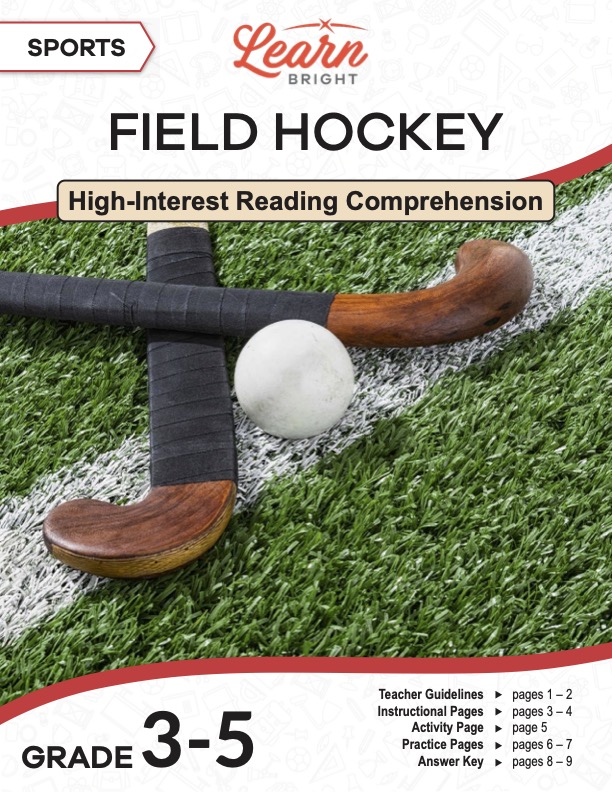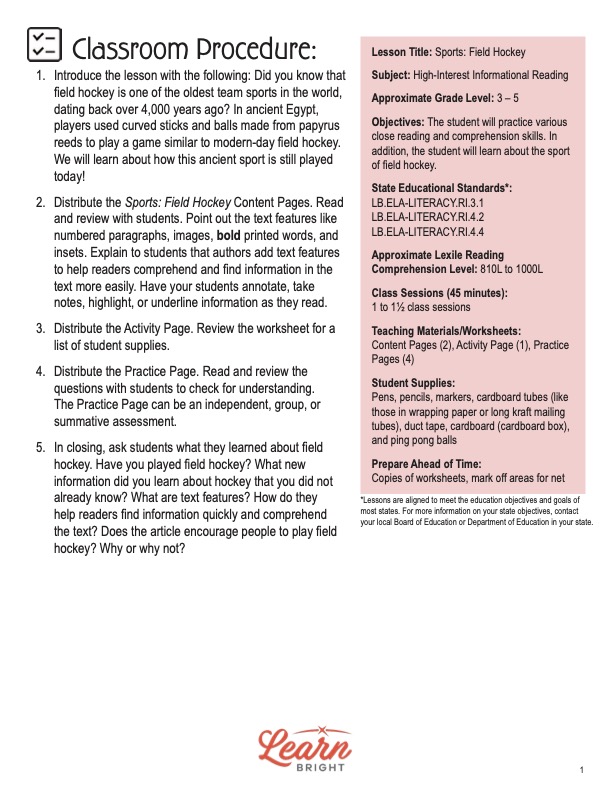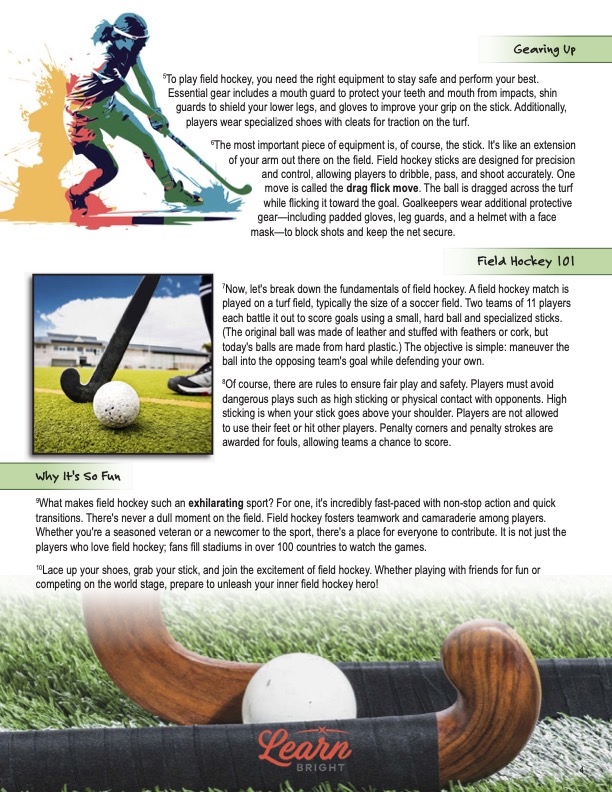Description
What our Sports: Field Hockey lesson plan includes
Lesson Objectives and Overview: Sports: Field Hockey is a high-interest reading comprehension lesson plan. As such, students will practice various close reading and comprehension skills. In addition, they will learn about the centuries-old sport of field hockey. This lesson is for students in 3rd grade, 4th grade, and 5th grade.
Classroom Procedure
Every lesson plan provides you with a classroom procedure page that outlines a step-by-step guide to follow. You do not have to follow the guide exactly. The guide helps you organize the lesson and details when to hand out worksheets. It also lists information in the yellow box that you might find useful. You will find the lesson objectives, state standards, and number of class sessions the lesson should take to complete in this area. In addition, it describes the supplies you will need as well as what and how you need to prepare beforehand. As far as materials go for this lesson, you’ll need cardboard tubes (like those in wrapping paper or long kraft mailing tubes), duct tape, cardboard (cardboard box), and ping pong balls.
Teacher Notes
The teacher notes page provides an extra paragraph of information to help guide the lesson and remind you what to focus on. It explains that you can teach this lesson in a whole-class setting or as an independent, small-group activity. The blank lines on this page are available for you to write out thoughts and ideas you have as you prepare the lesson.
SPORTS: FIELD HOCKEY LESSON PLAN CONTENT PAGES
History and Fame
The Sports: Field Hockey lesson plan contains two content pages. Have you ever seen ice hockey? Did you know that hockey can be played on open grassy fields as well? Today, we’re going to learn about the much warmer world of field hockey. Get ready to step onto the turf and discover some exciting facts about this widely beloved sport!
Did you know that field hockey has been played for centuries? That’s right! Variations of field hockey have been played since ancient times. However, today’s modern game version originated in England during the 19th century. Initially played on grass fields, field hockey gradually evolved into today’s dynamic sport. It gained international recognition and became an official Olympic sport in 1908 for men and 1980 for women!
Field hockey is a global sport played and enjoyed by millions worldwide. While it has strong roots in Europe and the Indian subcontinent, the popularity of field hockey has spread to every corner of the globe. Countries like the Netherlands, Germany, India, Australia, Argentina, and Pakistan have long-standing traditions of field hockey, passionate fans, and competitive leagues. There are over 3 million registered players worldwide, and even more people play recreationally.
Fun Facts for Field Hockey
Here are some fun facts. A field hockey shot can travel at 100 miles per hour. That’s faster than the speed limit on the highway! Field hockey began as a women’s sport. The Netherlands has won more Olympic gold medals in field hockey than any other country. It’s because they have a lot of passion for field hockey and skill in the game. Additionally, field hockey is one of the few sports where players can lift the ball off the ground using their sticks, leading to thrilling aerial maneuvers and jaw-dropping trick shots.
How to Play
To play field hockey, you need the right equipment to stay safe and perform your best. Essential gear includes a mouth guard to protect your teeth and mouth from impacts, shin guards to shield your lower legs, and gloves to improve your grip on the stick. Additionally, players wear specialized shoes with cleats for traction on the turf.
The most important piece of equipment is, of course, the stick. It’s like an extension of your arm out there on the field. Field hockey sticks are designed for precision and control, allowing players to dribble, pass, and shoot accurately. One move is called the drag flick move. The ball is dragged across the turf while flicking it toward the goal. Goalkeepers wear additional protective gear—including padded gloves, leg guards, and a helmet with a face mask—to block shots and keep the net secure.
Now, let’s break down the fundamentals of field hockey. A field hockey match is played on a turf field, typically the size of a soccer field. Two teams of 11 players each battle it out to score goals using a small, hard ball and specialized sticks. (The original ball was made of leather and stuffed with feathers or cork, but today’s balls are made from hard plastic.) The objective is simple: maneuver the ball into the opposing team’s goal while defending your own.
Of course, there are rules to ensure fair play and safety. Players must avoid dangerous plays such as high sticking or physical contact with opponents. High sticking is when your stick goes above your shoulder. Players are not allowed to use their feet or hit other players. Penalty corners and penalty strokes are awarded for fouls, allowing teams a chance to score.
Why It’s So Fun
What makes field hockey such an exhilarating sport? For one, it’s incredibly fast-paced with non-stop action and quick transitions. There’s never a dull moment on the field. Field hockey fosters teamwork and camaraderie among players. Whether you’re a seasoned veteran or a newcomer to the sport, there’s a place for everyone to contribute. It is not just the players who love field hockey; fans fill stadiums in over 100 countries to watch the games.
Lace up your shoes, grab your stick, and join the excitement of field hockey. Whether playing with friends for fun or competing on the world stage, prepare to unleash your inner field hockey hero!
SPORTS: FIELD HOCKEY LESSON PLAN WORKSHEETS
The Sports: Field Hockey lesson plan includes two worksheets: an activity worksheet and a practice worksheet. Each one will help students solidify their grasp of the material they learned throughout the lesson. You can refer to the classroom procedure guidelines to know when to hand out each worksheet.
MAKE YOUR OWN STICK ACTIVITY WORKSHEET
Students will get to create their own hockey stick for this activity. Using the supplies, they will first cut out the shape of a field hockey paddle, leaving a handle. They will then cut slits into the base of the cardboard tube and attach the tube to the paddle with duct tape. Finally, they can decorate the stick with a team name and colors. Using a ping pong ball, they can practice their shots.
SPORTS: FIELD HOCKEY PRACTICE WORKSHEET
The practice worksheet requires students to answer a series of 10 questions. These questions all relate to the content pages, so students will need to refer to them often for the answers. In addition, each question provides which reading tool the question corresponds to, such as text feature, vocabulary, or comprehension.
Worksheet Answer Keys
At the end of the lesson plan document is an answer key for the practice worksheet. The correct answers are all in red to make it easier for you to compare them with students’ responses. If you choose to administer the lesson pages to your students via PDF, you will need to save a new file that omits these pages. Otherwise, you can simply print out the applicable pages and keep these as reference for yourself when grading assignments.








